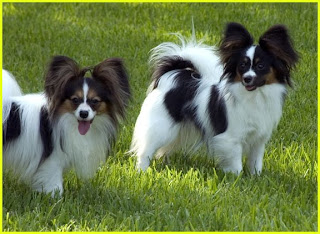
This is a dog that loves to make his humans happy and because of that, they are easy to train, but they do have a lot of energy and a playful personality so you will have to keep up with them! This is a dog full of energy (as I have mentioned) so good work outs or a good work schedule is a must to keep these furry little guys happy! They need a lot of time and dedication from their owner; if the owner is not up to spending a lot of time with his Papillon, then he should not bother to get one.
When training, the owner of the Papillon will have to show that he has confidence in himself and the commands that he is giving or else, the dog will pick up on this and decide that it would be better to do what he wants instead of listening to his owner. That’s why a demonstrated consistency is the best lesson he can learn from his master.They are very intelligent but also bossy and possessive, they do well in obedience training but housetraining can tend to be a problem sometimes.
This is a small dog, so careful consideration must be made before buying one if there are small children in the house as the dog can get hurt very easily. These are dogs that do well with older children and other pets, although sometimes they will try to show bigger dogs who’s boss, so care must be taken with the Papillon. These dogs do well in apartments and in houses as well. You might want to socialize your Papillon at an early age to make sure that the puppy grows up in to a confident and well behaved little dog.
The Papillon is the ultimate picture of elegance, with a dainty body and a big innocent look on his face; this is a dog that is enough to take your breath away! He has a long coat made up of hair that is pure silk to the touch, the color is usually white with tan, black or lemon patches. This breed has fringed ears and a beautiful full tail. This is a breed that can reach a height of up to 12 inches.
When it comes to grooming the Papillon one should not worry, the long silky coat is not prone to matting, just a good brush one to two times a week should be enough to keep his coat in top condition and looking beautiful; maybe a little bit more during the time of year when the dog is shedding. One thing that you will need to pay attention to is to keep the hair around the Papillon’s bottom trimmed (for hygienic purposes). Because of the long hair in the Papillon’s ears, he is prone to infection so care must be taken that they are clean and dry at all times.
When looking for a Papillon always take the time to find a good responsible breeder that can ensure the health and the breeding of his animals. Responsible breeders care for their puppies and the homes that they will be going to; try to avoid puppy mills because the dogs are usually raised in cruel conditions with no thought given to their breeding or their long-term health; you might end up with a puppy that will have all kinds of problems in the future, including health problems and mental stability problems. So take care as to whom you buy from.
Wonderful family pets, great companions and friends for the whole family to enjoy and love!


